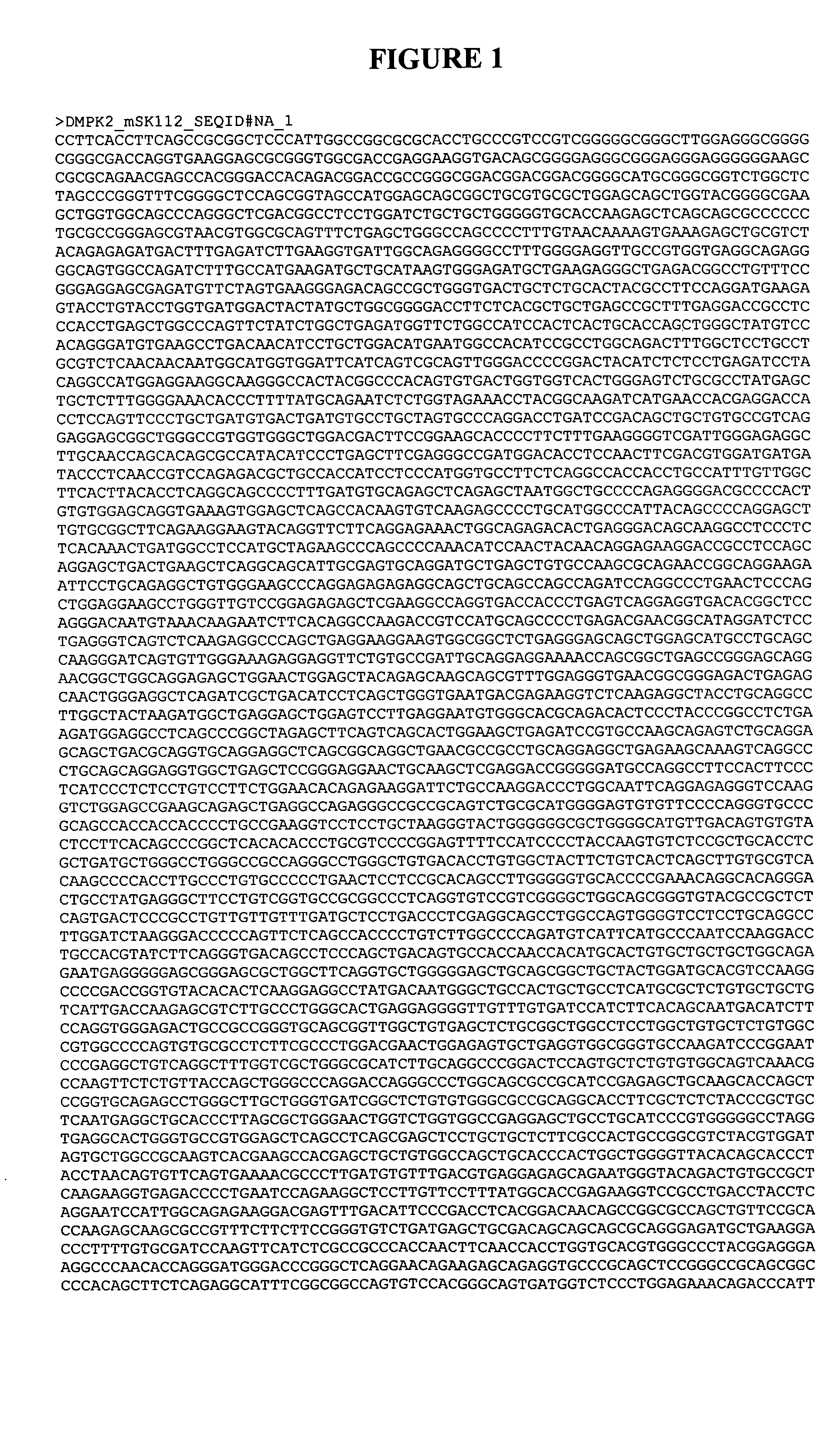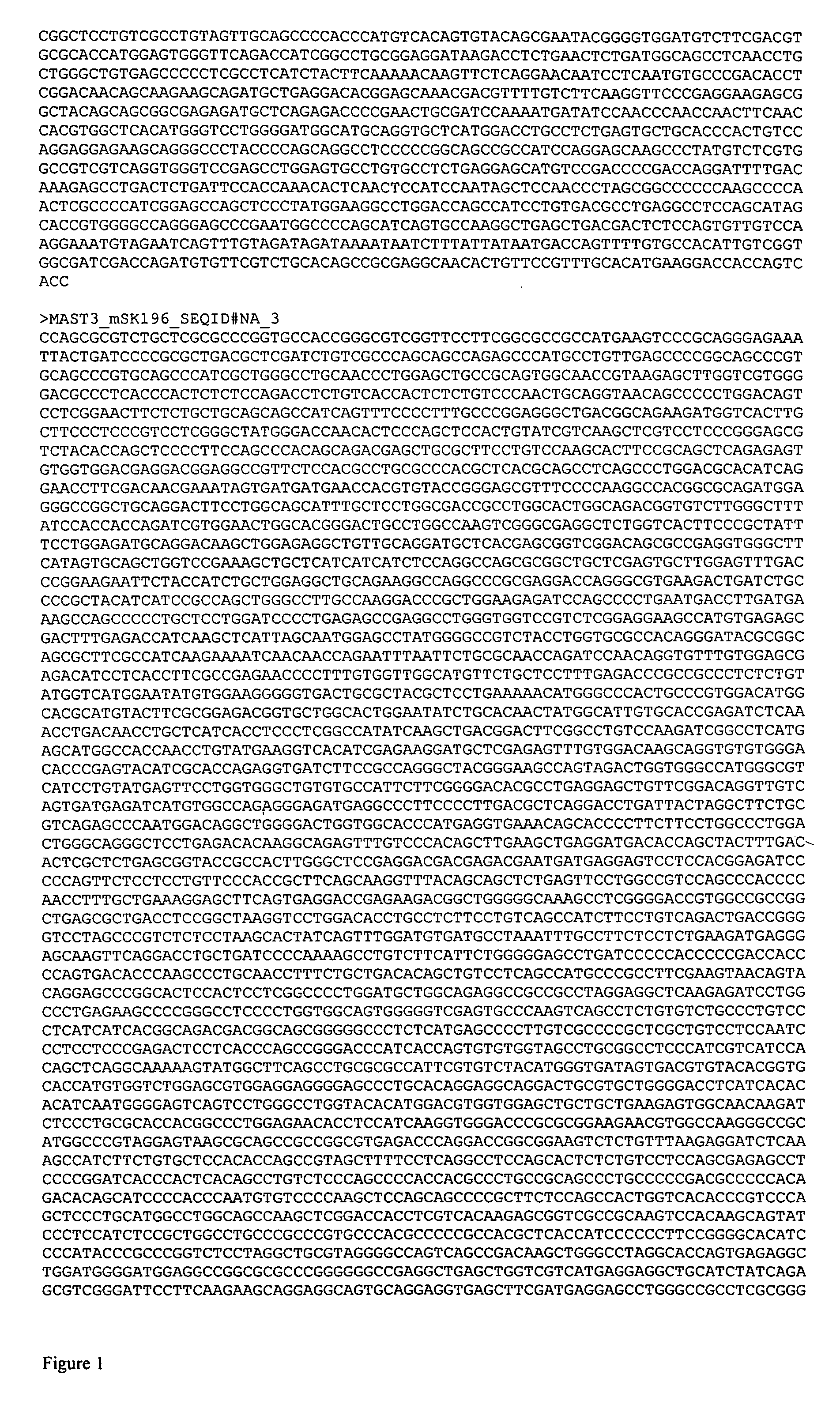Novel kinases
a kinase and polypeptide technology, applied in the field of kinase polypeptides and nucleotide sequences encoding the kinase polypeptides, can solve the problem that several mammalian kinases are unable to complement the nim phenotyp
- Summary
- Abstract
- Description
- Claims
- Application Information
AI Technical Summary
Benefits of technology
Problems solved by technology
Method used
Image
Examples
example 1
Identification and Characterization of Genomic Fragments Encoding Protein Kinases
[0467] Novel kinases were identified from the public Human Genome Sequencing project (www.ncbi.nlm.nih.gov / ) using a hidden Markov model (HMM) built with 70 mammalian and yeast kinase catalytic domain sequences. These sequences were chosen from a comprehensive collection of kinases such that no two sequences had more than 50% sequence identity. The genomic database entries were translated in six open reading frames and searched against the model using a Timelogic Decypher box with a Field programmable array (FPGA) accelerated version of HMMR2.1. The DNA sequences encoding the predicted protein sequences aligning to the HMMR profile were extracted from the original genomic database. The nucleic acid sequences were then clustered using the Pangea Clustering tool to eliminate repetitive entries. The putative protein kinase sequences were then sequentially run through a series of queries and filters to ide...
example 2
Isolation of cDNAs Encoding Mammalian Protein Kinases
[0475] Materials and Methods
[0476] Identification of Novel Clones
[0477] Total RNAs are isolated using the Guanidine Salts / Phenyl extraction protocol of Chomczynski and Sacchi (P. Chomczynski and N. Sacchi, Anal. Biochem. 162, 156 (1987)) from primary mammalian tumors, normal and tumor cell lines, normal mammalian tissues, and sorted mammalian hematopoietic cells. These RNAs are used to generate single-stranded cDNA using the Superscript Preamplification System (GIBCO BRL, Gaithersburg, Md.; Gerard, GF et al. (1989), FOCUS 11, 66) under conditions recommended by the manufacturer. A typical reaction uses 10 μg total RNA with 1.5 μg oligo(dT)12-18 in a reaction volume of 60 μL. The product is treated with RNaseH and diluted to 100 μL with H2O. For subsequent PCR amplification, 1-4 μL of this sscDNA is used in each reaction.
[0478] Degenerate oligonucleotides are synthesized on an Applied Biosystems 3948 DNA synthesizer using estab...
example 3
Expression Analysis of Mammalian Protein Kinases
[0484] Materials and Methods
[0485] Northern Blot Analysis
[0486] Northern blots are prepared by running 10 μg total RNA isolated from 60 mammalian tumor cell lines (such as HOP-92, EKVX, NCI-H23, NCI-H226, NCI-H322M, NCI-H460, NCI-H522, A549, HOP-62, OVCAR-3, OVCAR-4, OVCAR-5, OVCAR-8, IGROV1, SK-OV-3, SNB-19, SNB-75, U251, SF-268, SF-295, SF-539, CCRF-CEM, K-562, MOLT-4, HL-60, RPMI 8226, SR, DU-145, PC-3, HT-29, HCC-2998, HCT-116, SW620, Colo 205, HTC15, KM-12, UO-31, SN12C, A498, CaKil, RXF-393, ACHN, 786-0, TK-10, LOX IMVI, Malme-3M, SK-MEL-2, SK-MEL-5, SK-MEL-28, UACC-62, UACC-257, M14, MCF-7, MCF-7 / ADR RES, Hs578T, MDA-MB-231, MDA-MB-435, MDA-N, BT-549, T47D), from mammalian adult tissues (such as thymus, lung, duodenum, colon, testis, brain, cerebellum, cortex, salivary gland, liver, pancreas, kidney, spleen, stomach, uterus, prostate, skeletal muscle, placenta, mammary gland, bladder, lymph node, adipose tissue), and 2 mammal...
PUM
| Property | Measurement | Unit |
|---|---|---|
| Fraction | aaaaa | aaaaa |
| Affinity | aaaaa | aaaaa |
Abstract
Description
Claims
Application Information
 Login to View More
Login to View More - R&D
- Intellectual Property
- Life Sciences
- Materials
- Tech Scout
- Unparalleled Data Quality
- Higher Quality Content
- 60% Fewer Hallucinations
Browse by: Latest US Patents, China's latest patents, Technical Efficacy Thesaurus, Application Domain, Technology Topic, Popular Technical Reports.
© 2025 PatSnap. All rights reserved.Legal|Privacy policy|Modern Slavery Act Transparency Statement|Sitemap|About US| Contact US: help@patsnap.com



